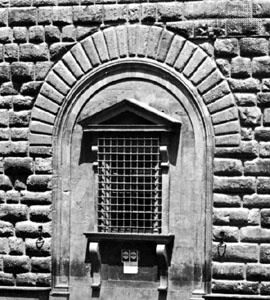rustication
architecture
 in architecture, type of decorative masonry achieved by cutting back the edges of stones to a plane surface while leaving the central portion of the face either rough or projecting markedly. Rustication provides a rich and bold surface for exterior masonry walls.
in architecture, type of decorative masonry achieved by cutting back the edges of stones to a plane surface while leaving the central portion of the face either rough or projecting markedly. Rustication provides a rich and bold surface for exterior masonry walls.Rusticated masonry is found as early as the platform of the tomb of Cyrus II (the Great) at Pasargadae in Persia (560 BC) and was commonly used for Greek and Hellenistic retaining walls and terraces. It was similarly used by the Romans (ancient Rome), who also rusticated such utilitarian structures as aqueducts. The Romans also realized the purely ornamental value of rustication and used it decoratively in such structures as the Porta Maggiore at Rome (1st century AD), in which the rustication is rough, and the Temple of Augustus at Vienne, France, in which it is carefully finished.
Early Renaissance Italian architects further developed the tradition of rustication, using it effectively to decorate palaces in the 15th century. Thus, in the Pitti Palace (1458), the Medici-Riccardi Palace (1444–59), and the Strozzi Palace (c. 1489), all in Florence, carefully designed rustication is the chief ornamental element. During the Mannerist and Baroque periods, rustication assumed great importance in garden and villa design. Fantastic surfaces were employed on the projecting portions of the stones, such as vermiculated work, in which the surface is covered with wavy, serpentine sinkages or is treated with vertical, dribbled forms. Sometimes the stones had sides beveled and brought to an abrupt point, or ridge, in the centre. The use of rustication was introduced into England by Inigo Jones (Jones, Inigo) and became a dominant feature in much English stonework during the 17th and 18th centuries.
- Le Parisien
- Le Pautre, Antoine
- Lepchā
- Le Pen, Jean-Marie
- Le Petit-Quevilly
- Lepidodendron
- lepidolite
- lepidopteran
- Lepidozamia
- Lepidus, Marcus Aemilius
- Le Play, Frédéric
- Lepontine Alps
- Le Port
- Le Poulain, Jean
- leprechaun
- leprosy
- Lepsius, Richard
- Leptaena
- Leptines, Law of
- Leptis Magna
- Leptis Minor
- leptochlorite
- Leptodactylidae
- Leptodesma
- Leptodus